实验四 外设驱动程序设计
本小组成员:
- 20175209 王梓鸿
- 20175213 吕正宏
- 20175214 林郅聪
实验四 外设驱动程序设计-1
实验内容:
-
1.学习资源中全课中的“hqyj.嵌入式Linux应用程序开发标准教程.pdf”中的第十一章。
-
2.提交康奈尔笔记的照片。
小组成员学习笔记:
- 20175209
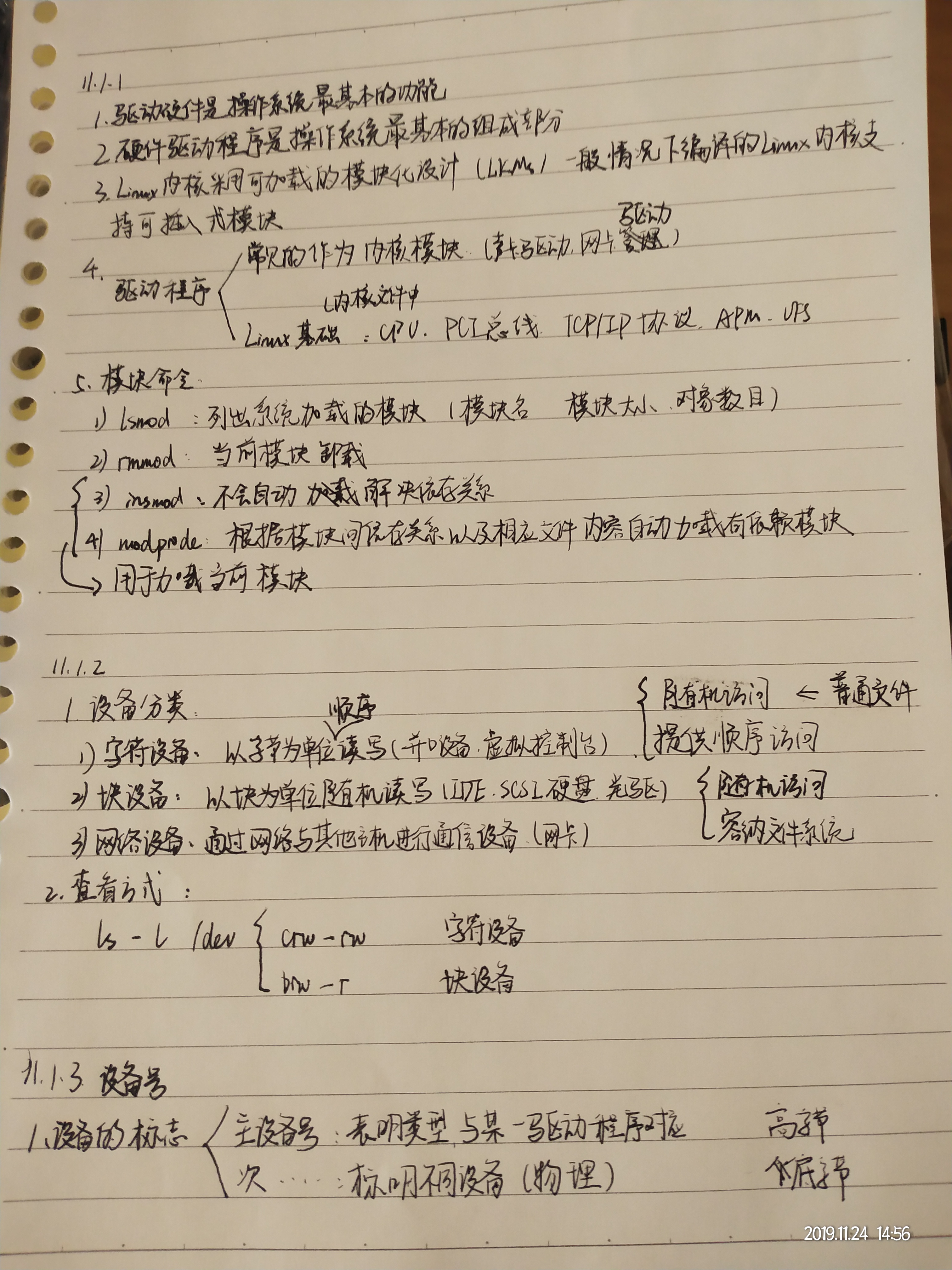

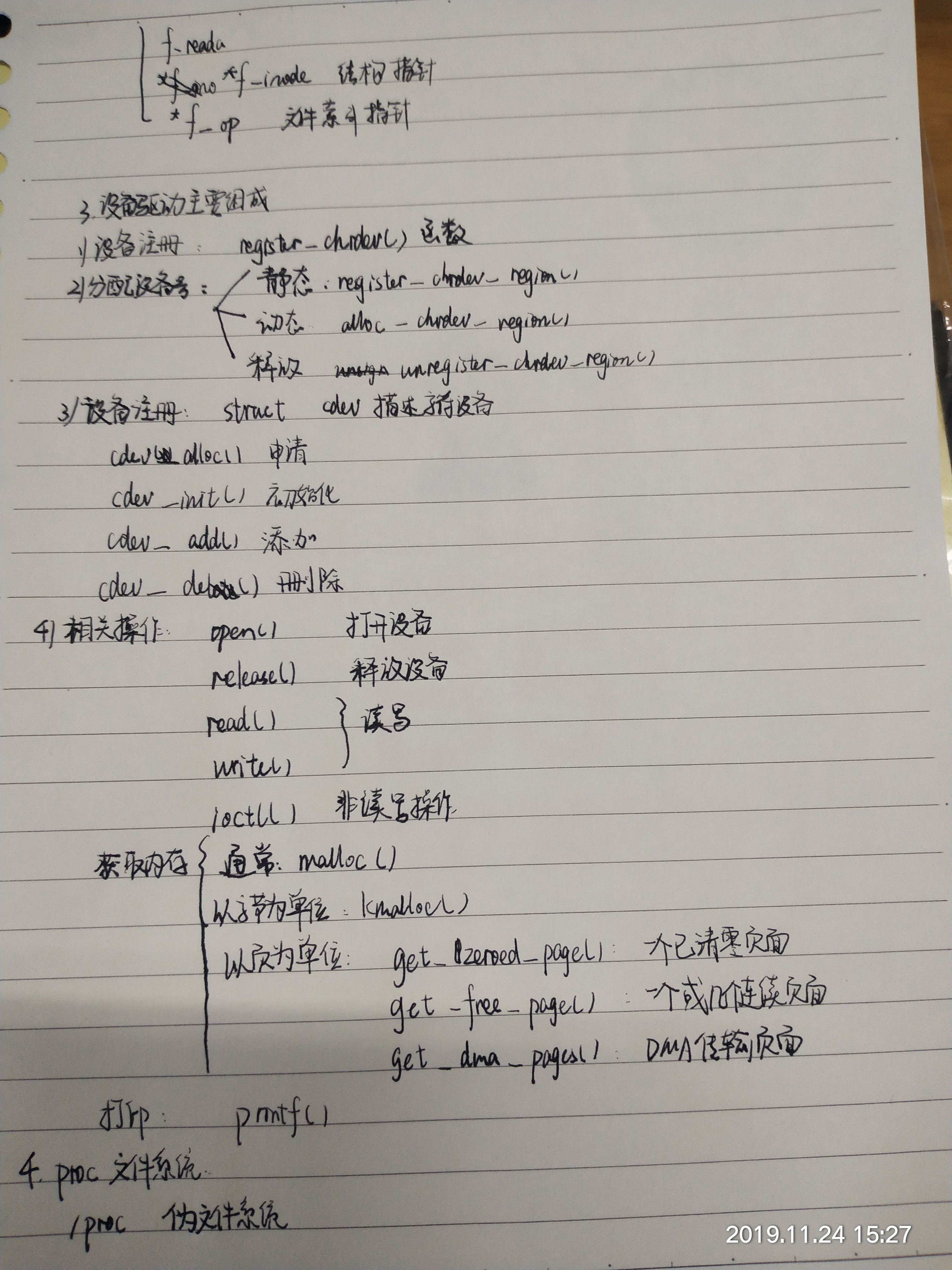

- 20175213

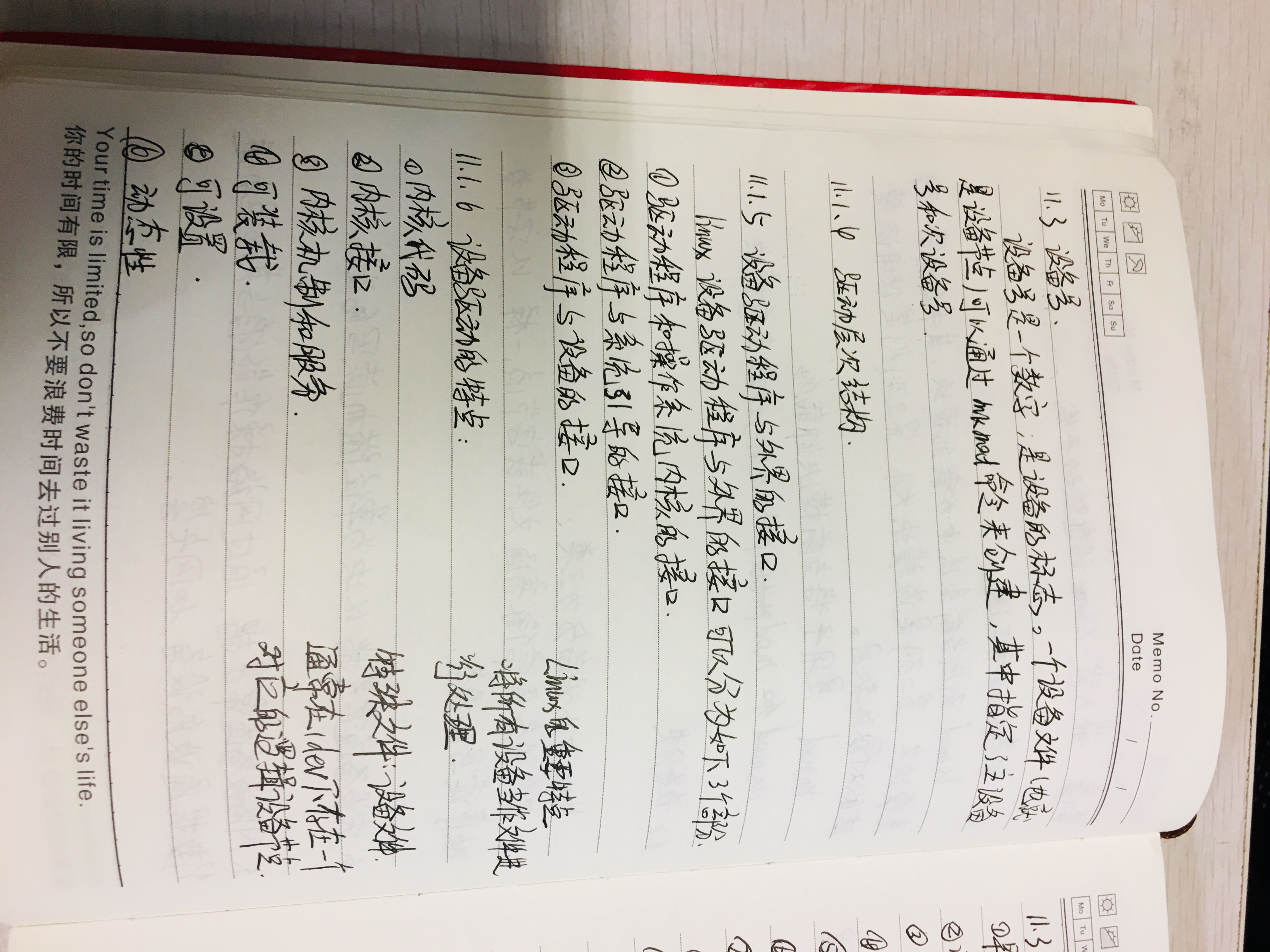
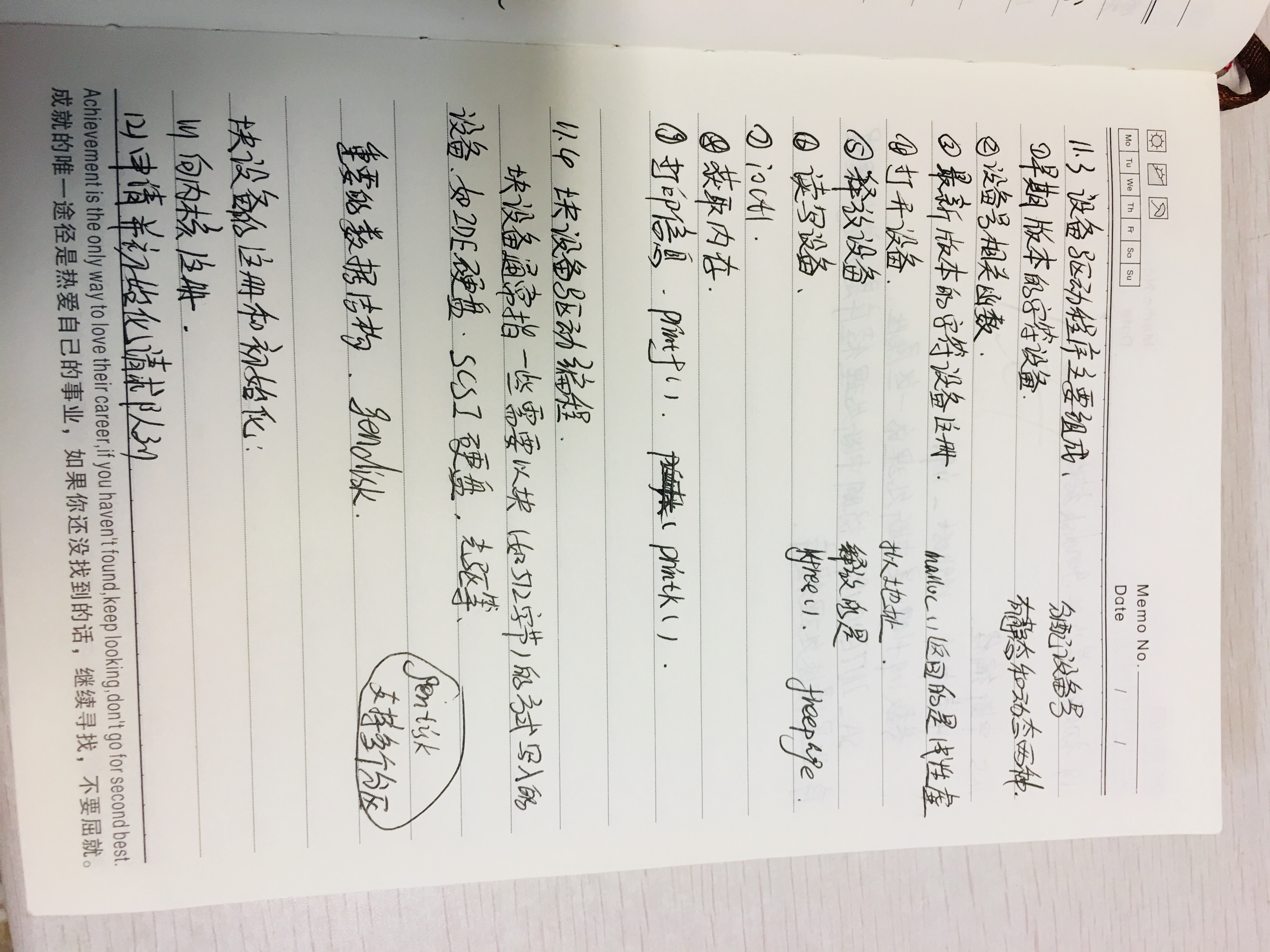

- 20175214
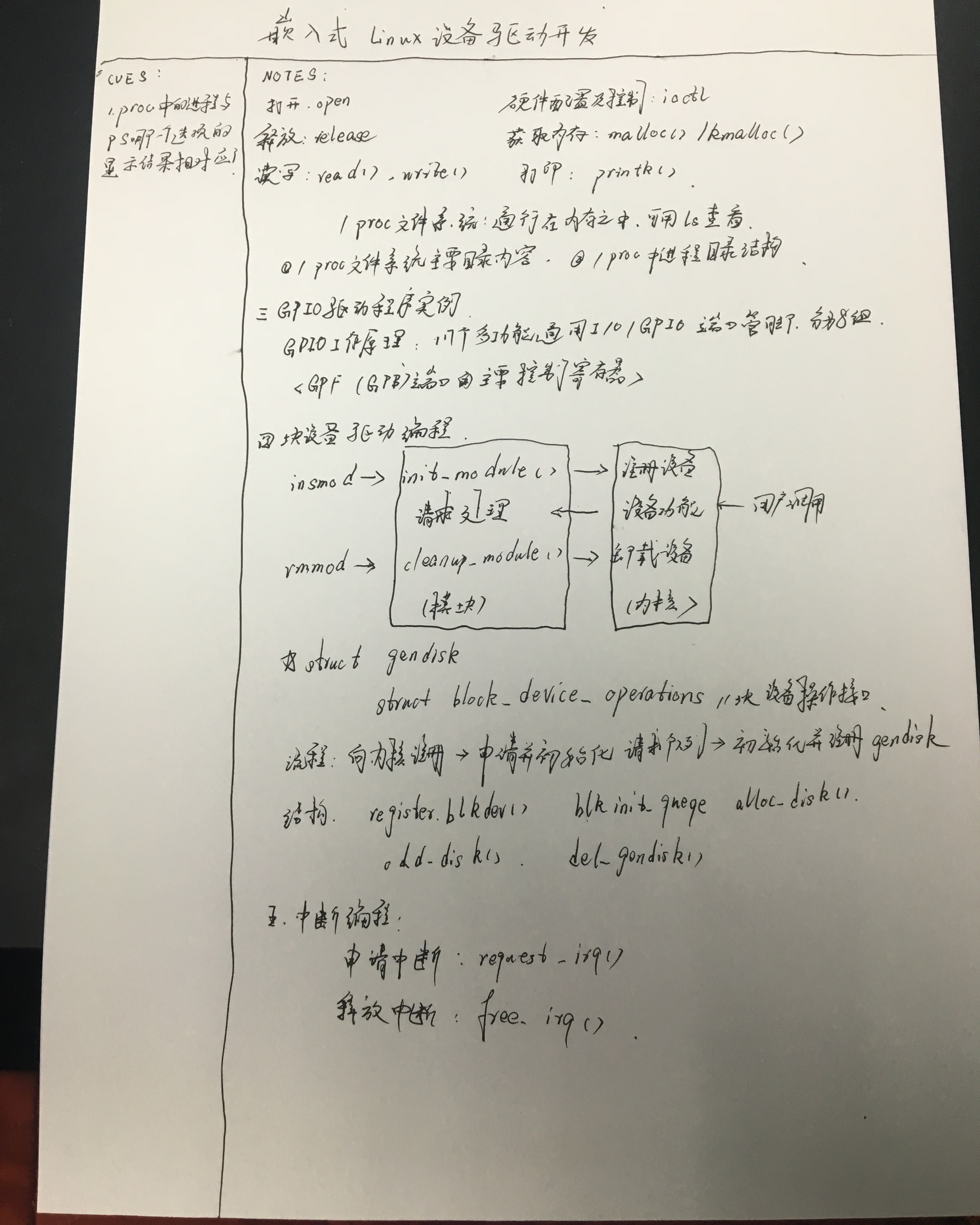
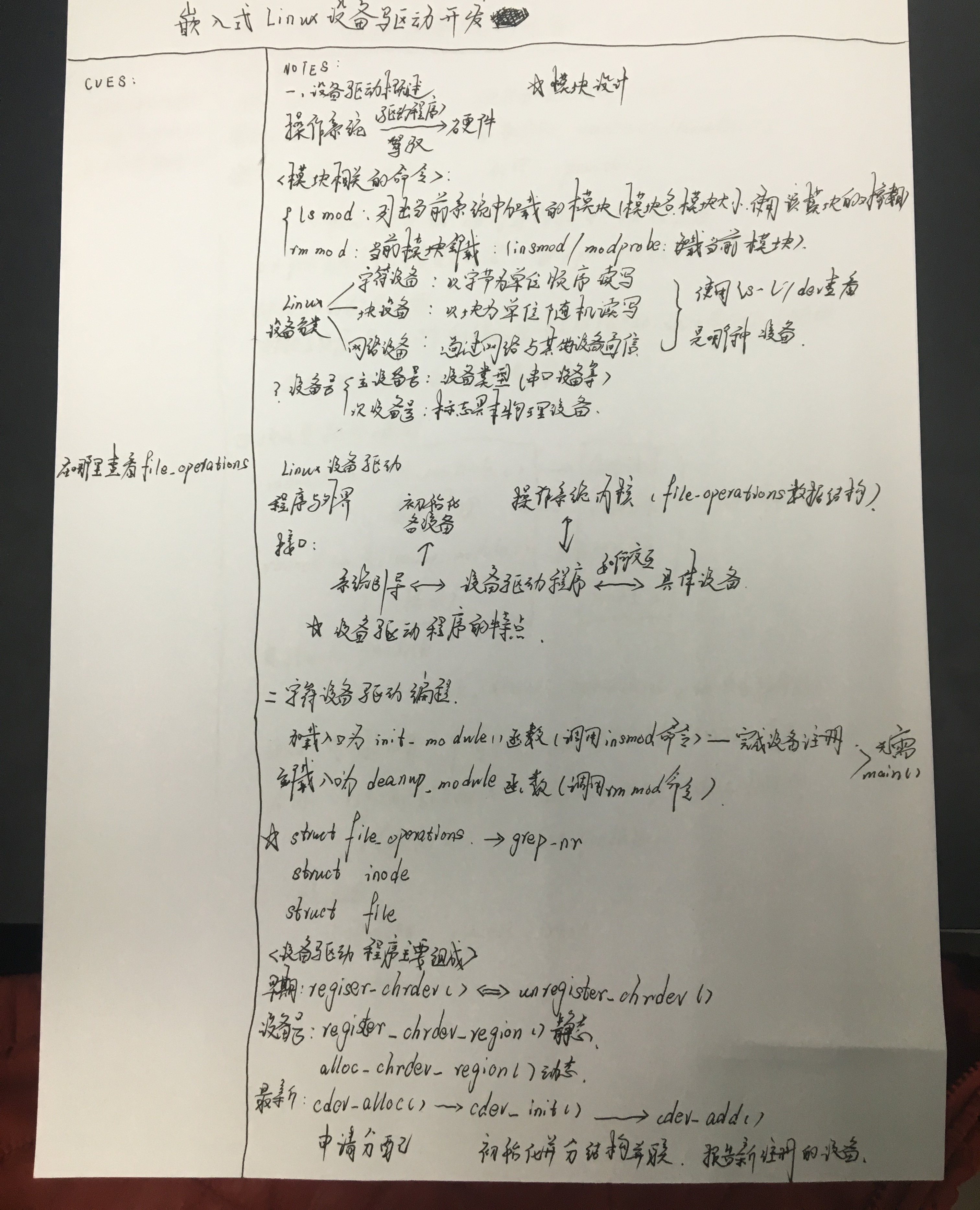
实验四 外设驱动程序设计-2
实验内容:
-
1.在Ubuntu完成资源中全课中的“hqyj.嵌入式Linux应用程序开发标准教程.pdf”中的第十一章的test试验。
-
2.提交编译,加载模块,卸载模块,测试运行的截图。
实验步骤:
-
设备驱动概述:
-
1.操作系统通过各种驱动程序来驾驭硬件设备,硬件驱动程序是操作系统最基本的组成部分,常见的驱动程序作为内核模块来加载功能。
-
2.linux系统将设备分为3类:字符设备,块设备和网络设备。
-
3.linux驱动设备有2个部分:中断处理程序和设备服务子程序。设备服务器一般用中断的方式向设备驱动程序发出输入/输出请求。
-
4.设备驱动程序使用模块动态加载到内核中,在调用
insmod命令时被加载,入口点是init_module()函数,在调用rmmod命令时被卸载,入口点是cleanup_module()函数.
-
-
根据书第十一章最后关于字符设备的test实验中代码,将test_drv.c,test.c,Makefile,test_drv_load,test_drv_unload文件敲入,保存在文件夹内。[注]:敲入书中代码时要多检查,避免错误
- test_drv.c代码:
#include <linux/module.h>
#include <linux/init.h>
#include <linux/fs.h>
#include <linux/kernel.h>
#include <linux/slab.h>
#include <linux/types.h>
#include <linux/errno.h>
#include <linux/cdev.h>
#include <asm/uaccess.h>
#define TEST_DEVICE_NAME "test_dev"
#define BUFF_SZ 1024
/*全局变量*/
static struct cdev test_dev;
unsigned int major =0;
static char *data = NULL;
/*读函数*/
static ssize_t test_read(struct file *file,
char *buf, size_t count, loff_t *f_pos)
{
int len;
if (count < 0 )
{
return -EINVAL;
}
len = strlen(data);
count = (len > count)?count:len;
if (copy_to_user(buf, data, count)) /* ?内核??的数????用户??*/
{
return -EFAULT;
}
return count;
}
/*写函数*/
static ssize_t test_write(struct file *file, const char *buffer,
size_t count, loff_t *f_pos)
{
if(count < 0)
{
return -EINVAL;
}
memset(data, 0, BUFF_SZ);
count = (BUFF_SZ > count)?count:BUFF_SZ;
if (copy_from_user(data, buffer, count)) /* 将用户缓冲的数据复制到内核空间*/
{
return -EFAULT;
}
return count;
}
/*打开函数*/
static int test_open(struct inode *inode, struct file *file)
{
printk("This is open operation
");
/* 分配并初始化缓冲区*/
data = (char*)kmalloc(sizeof(char) * BUFF_SZ, GFP_KERNEL);
if (!data)
{
return -ENOMEM;
}
memset(data, 0, BUFF_SZ);
return 0;
}
/*关闭函数*/
static int test_release(struct inode *inode,struct file *file)
{
printk("This is release operation
");
if (data)
{
kfree(data); /* 释放缓冲区*/
data = NULL; /* 防止出现野指针*/
}
return 0;
}
/* 创建、初始化字符设备,并且注册到系统*/
static void test_setup_cdev(struct cdev *dev, int minor,
struct file_operations *fops)
{
int err, devno = MKDEV(major, minor);
cdev_init(dev, fops);
dev->owner = THIS_MODULE;
dev->ops = fops;
err = cdev_add (dev, devno, 1);
if (err)
{
printk (KERN_NOTICE "Error %d adding test %d", err, minor);
}
}
/* 虚拟设备的 file_operations 结构 */
static struct file_operations test_fops =
{
.owner = THIS_MODULE,
.read = test_read,
.write = test_write,
.open = test_open,
.release = test_release,
};
/*模块注册入口*/
int init_module(void)
{
int result;
dev_t dev = MKDEV(major, 0);
if (major)
{/* 静态注册一个设备,设备号先前指定好,并设定设备名,用cat /proc/devices 来查看 */
result = register_chrdev_region(dev, 1, TEST_DEVICE_NAME);
}
else
{
result = alloc_chrdev_region(&dev, 0, 1, TEST_DEVICE_NAME);
}
if (result < 0)
{
printk(KERN_WARNING "Test device: unable to get major %d
", major);
return result;
}
test_setup_cdev(&test_dev, 0, &test_fops);
printk("The major of the test device is %d
", major);
return 0;
}
/*卸载模块*/
void cleanup_module(void)
{
cdev_del(&test_dev);
unregister_chrdev_region(MKDEV(major, 0), 1);
printk("Test device uninstalled
");
}
- 虚拟设备的驱动程序的Makefile代码如下所示:
ifeq ($(KERNELRELEASE),)
KERNELDIR ?= /lib/modules/$(shell uname -r)/build
PWD := $(shell pwd)
modules:
$(MAKE) -C $(KERNELDIR) M=$(PWD) modules
modules_install:
$(MAKE) -C $(KERNELDIR) M=$(PWD) modules_install
clean:
rm -rf *.o *~ core .depend .*.cmd *.ko *.mod.c .tmp_versions
.PHONY: modules_install clean
else
obj-m := test_drv.o
endif
- test_drv_load代码:
#!/bin/sh
# 驱动模块名称
module="test_drv"
# 设备名称。在/proc/devices 中出现
device="test_dev"
# 设备文件的输性
mode="664"
group="david"
# 删除已存在的设备节点
rm -f /dev/${device}
# 加载驱动模块
/sbin/insmod -f ./$module.ko $* || exit 1
# 查到设备的主设备号
major=`cat /proc/devices | awk "\$2=="$device" {print \$1}"`
# 创建设备文件节点
mknod /dev/${device} c $major 0
# 设置设备文件属性
chgrp $group /dev/${device}
chmod $mode /dev/${device}
- test_drv_unload代码:
#!/bin/sh
module="test_drv"
device="test_dev"
# 卸载驱动模块
/sbin/rmmod $module $* || exit 1
# 删除设备文件
rm -f /dev/${device}
exit 0
- test.c代码:
#include <stdio.h>
#include <stdlib.h>
#include <string.h>
#include <sys/stat.h>
#include <sys/types.h>
#include <unistd.h>
#include <fcntl.h>
#define TEST_DEVICE_FILENAME "/dev/test_dev" /* 设备文件名*/
#define BUFF_SZ 1024 /* 缓冲大小 */
int main()
{
int fd, nwrite, nread;
char buff[BUFF_SZ]; /*缓冲区*/
/* 打开设备文件 */
fd = open(TEST_DEVICE_FILENAME, O_RDWR);
if (fd < 0)
{
perror("open");
exit(1);
}
do
{
printf("Input some words to kernel(enter 'quit' to exit):");
memset(buff, 0, BUFF_SZ);
if (fgets(buff, BUFF_SZ, stdin) == NULL)
{
perror("fgets");
break;
}
buff[strlen(buff) - 1] = '�';
if (write(fd, buff, strlen(buff)) < 0) /* 向设备写入数据 */
{
perror("write");
break;
}
if (read(fd, buff, BUFF_SZ) < 0) /* 从设备读取数据 */
{
perror("read");
break;
}
else
{
printf("The read string is from kernel:%s
", buff);
}
} while(strncmp(buff, "quit", 4));
close(fd);
exit(0);
}
- 首先在虚拟设备驱动源码目录下编译并加载驱动模块(但得先给脚本文件增加可执行权限:
chmod +x ./test_drv_load,再以管理员身份运行加载脚本:sudo ./test_drv_load):
$ make clean;make
$ ./test_drv_load

- 编译运行test.c
$ gcc –o test test.c
$ ./test
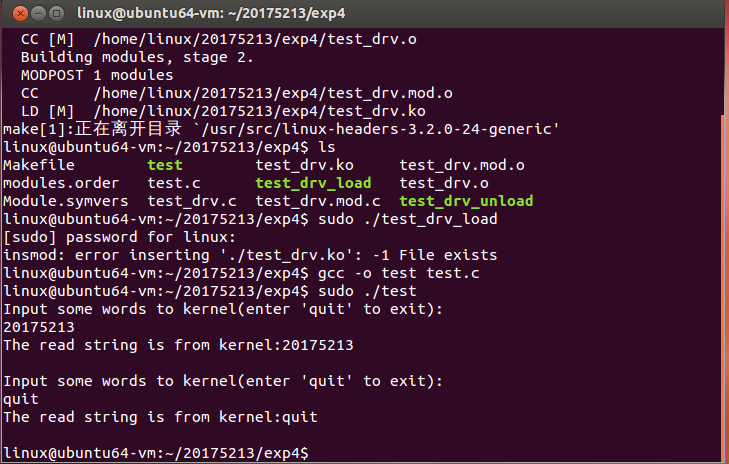
- 最后,卸载驱动程序:
$ ./test_drv_unload
- 通过 dmesg 命令可以查看内核打印的信息:
$ dmesg|tail –n 10
……
The major of the test device is 250
This is open operation
This is release operation
Test device uninstalled

实验四 外设驱动程序设计-3
实验内容:
-
1.在实验箱中通过交叉编译完成test实验。
-
2.提交编译,加载模块,卸载模块,测试运行的截图。
实验步骤:
- 此步骤由于实验室问题未做。
实验中遇到的问题
- 问题1:Makefile文件运行时出现 Makefile:2: *** 遗漏分隔符 。 停止。和如图所示的其他问题

-
解决:gcc、rm、cp前面是tab分割符,不能用空格,否则会出现:“makefile:2: *** 遗漏分隔符 。 停止。”这样的错误提示。make中规定每一Shell命令之前的开头必须使用字符。
-
问题2:test文件运行时,出现“NO such device or address”的提示

- 解决:将test文件内第八行的“test_dev”改为“stdout”即可运行。
